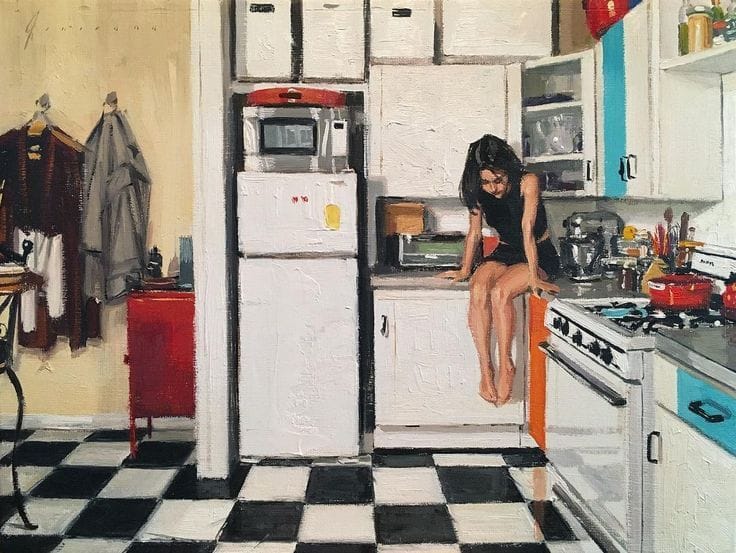From the movie "The Substance": an exploration of the eternal inner battle of the self. A reflection on the desire to disappear.
Have you ever dreamt of a better version of yourself? Younger, more beautiful, more perfect?
A perfect balance of seven days each. The one and only thing not to forget: You are One. You can’t escape from yourself.
These are the premises of using the Substance: a green injection that directly affects your DNA to create a new version of yourself—more beautiful, more perfect.
The new movie from French director Coralie Fargeat received five Oscar nominations, including Best Picture and Best Actress for Demi Moore who, much to the surprise and disappointment of many, was overshadowed by the young Mikey Madison. This body horror motion picture offers a stark, often repulsive reflection on the eternal individual and the inner struggle of the human being, specifically in this case, the female experience.
The plot centers on Elisabeth Sparkle, a Hollywood star in the twilight of her career. Her downfall is dictated by the male gaze, embodied by Harvey, the producer portrayed by Dennis Quaid. This male gaze ultimately decides when a woman's career should end, especially within the framework of Hollywood's dynamics. As Harvey states, “People always ask for something new. Renewal is inevitable. And at 50... Well... It stops.”
The audience begins to perceive how Elisabeth, forced to conform to the rules of patriarchy, starts to see herself as something that no longer works—a worn-out, damaged, forgotten toy. It is in this precarious state of self-perception that she decides to undergo the Substance program. Through an injection that acts directly on Elisabeth's DNA, the matrix is altered, creating a new individual—more beautiful, more perfect. The two versions of her each have one week. The crucial detail not to forget is that neither version can abuse or exceed the allotted time. What one version takes, the other loses. You are one. Balance is key.
What happens, then, is that Elisabeth effectively disappears for a week, succumbing to Sue, her other version. During Sue’s week, Elisabeth lies motionless on the bathroom floor, ceasing to exist. The same dynamic occurs during Elisabeth’s week. However, what changes is Elisabeth's perception is that her week of existence now appears meaningless. She feels completely crushed and supplanted by Sue, as if her identity had been annihilated by the perfection of the other.
This realization gives rise to a conflict between the two versions, which constantly struggle to eliminate each other. If we asked Sue - if you could eliminate something of your choice from the world, what would it be? - her answer would undoubtedly be Elisabeth. And what if we asked Elisabeth? Her answer would be Sue.
The only person with the power to stop this destructive spiral would be Elisabeth herself, the matrix, the origin of it all. A simple gesture: a phone call to The Substance program’s central office, asking to halt the process.
But what is the real problem? The issue is that Sue, in her attempt to destroy Elisabeth, has stolen time from her counterpart. In this game of subtraction and addition, Elisabeth’s body is now irreparably damaged, transformed into something monstrous. Thus, stopping the process would not mean going back: Elisabeth’s body will never return to its original state.
This film strikes so powerfully because it speaks of a shared drama—the hatred towards oneself. It takes us back to those moments when we wished our wrinkles, our weight, our nose, our voice, our skin, our thoughts, would disappear, when we wished we could disappear. But all this erasing, changing, vanishing only leads to self-destruction.
Do we really want to trade a life of experiences for this?
As Jonathan Cook states in his brilliant piece for Medium Magazine:
“We’ve all been younger than we are now. And we’ll all soon be older than we are right now. And given enough time, we’ll be much older.Real human relationships are difficult and messy. Hollywood is glamorous and seductive. Science and technology have achieved genuine successes, promise more, and tease us with hope it doesn’t (and can’t) deliver on. We all face the existential riddle—“The Problem”—of old age, sickness, and death. And atheist, nihilist, existentialist or not, we all look for ways to overcome it. [...] But when we look for shortcuts, the results can be tragic. In this sense, The Substance offers us a warning. We should listen." [1]
Cook, J. (2025). The Substance as a Modern Fairy Tale of Inner Conflict. Medium. https://livereal.medium.com/the-substance-as-a-modern-fairy-tale-of-inner-conflict-2ccdbe8ec5f6 ↩︎




Comments ()